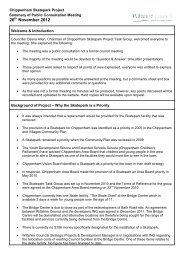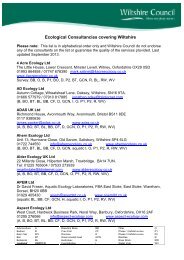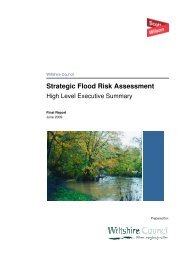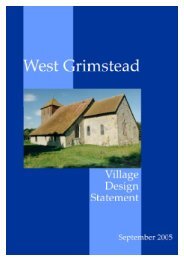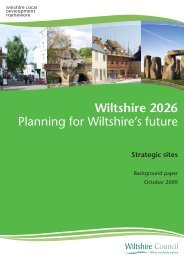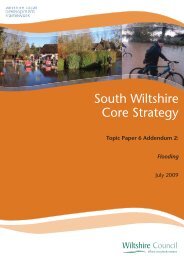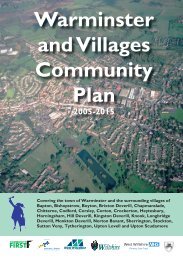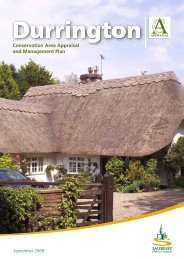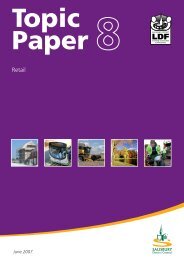South Wiltshire Core Strategy - Wiltshire Council
South Wiltshire Core Strategy - Wiltshire Council
South Wiltshire Core Strategy - Wiltshire Council
You also want an ePaper? Increase the reach of your titles
YUMPU automatically turns print PDFs into web optimized ePapers that Google loves.
6.37 Contingency and Flexibility<br />
Only where compelling evidence exists of when the sites will be developed have they<br />
been allocated in this strategy. However, the <strong>Strategy</strong> does have in-built contingency<br />
and flexibility, should sites not come forward as projected. This is based on the<br />
frontloading approach to the delivery of housing, as described above. If the housing<br />
trajectory information on site deliverability and infrastructure provision indicates that<br />
by 2026 there will be a 20% or more variation compared to the amount of housing<br />
required, a SPD will be prepared, to consider altering the release of housing land in<br />
the longer term. The detailed mechanism for bringing forward reserve sites into the<br />
rolling five-year housing supply will be set out in the SPD/Site Allocations DPD. This<br />
approach is flexible, responsive and able to adapt to changing circumstances 58 .<br />
6.38 A deliberate strategy of frontloading the <strong>Core</strong> <strong>Strategy</strong> has been produced and all the<br />
strategic sites have been identified as being able to deliver within the early years of<br />
the plan.<br />
6.39 Not enough homes have been delivered to meet local needs in the past ten years in<br />
south <strong>Wiltshire</strong>. However, the benefits of frontloading the <strong>Core</strong> <strong>Strategy</strong> go beyond<br />
simply fulfilling the quanta of housing required. The shortage of housing has an<br />
impact on open market house prices in the area, this in turn impacts on economic<br />
growth due to the lack of a local workforce living in the area.<br />
6.40 The shortfall in housing provision contributes to the demographic of the area, and in<br />
turn the aging population impacts on viability, making the area less economically<br />
competitive. There is consequently a high level of out-commuting for work purposes,<br />
which impacts on the self-containment and sustainability of south <strong>Wiltshire</strong>.<br />
6.41 Addressing these issues requires a flexible approach and the strategy of frontloading<br />
provides this by only identifying strategic sites where there is evidence of a<br />
commitment to start delivery within the first five years of the plan. There is a<br />
contingency in this approach of oversupply in that the failure to develop any one or<br />
two of the sites would not prevent the overall aims of the <strong>Strategy</strong> being achieved<br />
through the delivery of the other sites.<br />
6.42 The delivery of the other strategic sites will allow the decanting of business from the<br />
Churchfields site, which is central to the economic policies of the <strong>Strategy</strong>. Whilst it is<br />
acknowledged that the redevelopment of Churchfields relies on other sites, it is again<br />
the case that the failure of any one or two of those sites would not hamper the overall<br />
strategy.<br />
6.43 Notwithstanding this, and although every effort has been made to ensure all the<br />
strategic sites will deliver housing within the first five years of the plan, there is a need<br />
to provide further contingency to ensure that uncertain market conditions or<br />
unforeseen events will not prevent the delivery of the <strong>Strategy</strong>.<br />
6.44 This further contingency is provided in that, should any of these sites fail to come<br />
forward, alternative sites can be identified within an SSA DPD. Areas of Search for<br />
the alternative sites would be predominantly centred on the major settlements of<br />
Salisbury and Amesbury, and would be identified through a number of stages:<br />
Identification of constraints; Identification of less-constrained areas; Assessment of<br />
less constrained areas against national and regional policy and sustainability<br />
objectives; Identification of the most suitable sites for allocation, including a<br />
consideration of landscape character.<br />
6.45 Other sources of Growth<br />
<strong>Core</strong> Policy 2 sets out the distribution of strategic growth that will be delivered<br />
through the strategic allocations, and in order to meet overall requirements it is also<br />
necessary to take account of other sources of supply, so that the levels of delivery<br />
58 This approach is consistent with PPS3 para 63.<br />
43



